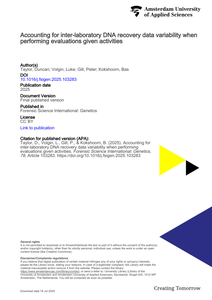BackgroundGait analysis has been used for decades to quantify knee function in patients with knee osteoarthritis; however, it is unknown whether and to what extent inter-laboratory differences affect the comparison of gait data between studies. Therefore, the aim of this study was to perform an inter-laboratory comparison of knee biomechanics and muscle activation patterns during gait of patients with knee osteoarthritis.MethodsKnee biomechanics and muscle activation patterns from patients with knee osteoarthritis were analyzed, previously collected at Dalhousie University (DAL: n = 55) and Amsterdam UMC, VU medical center (VUmc: n = 39), using their in-house protocols. Additionally, one healthy male was measured at both locations. Both direct comparisons and after harmonization of components of the protocols were made. Inter-laboratory comparisons were quantified using statistical parametric mapping analysis and discrete gait parameters.ResultsThe inter-laboratory comparison showed offsets in the sagittal plane angles, moments and frontal plane angles, and phase shifts in the muscle activation patterns. Filter characteristics, initial contact identification and thigh anatomical frame definitions were harmonized between the laboratories. After this first step in protocol harmonization, the offsets in knee angles and sagittal plane moments remained, but the inter-laboratory comparison of the muscle activation patterns improved.ConclusionsInter-laboratory differences obstruct valid comparisons of gait datasets from patients with knee osteoarthritis between gait laboratories. A first step in harmonization of gait analysis protocols improved the inter-laboratory comparison. Further protocol harmonization is recommended to enable valid comparisons between labs, data-sharing and multicenter trials to investigate knee function in patients with knee osteoarthritis.
MULTIFILE

A large, recently published, inter-laboratory study by the ReAct group has shown that there is considerable variability in DNA recovery that exists between forensic laboratories. The presence of this inter-laboratory variability presents issues when one laboratory wishes to carry out an evaluation and needs to use the data produced by another laboratory. One option proposed by the ReAct group is for laboratories to carry out a calibration exercise so that appropriate adjustments between laboratories can be made. This will address some issues, but leave others unanswered, such as how to make use of the decades of transfer and persistence data that has already been published. In this work we present a method to utilise data produced in other laboratories (whether it provides DNA amounts or a probability of transfer) that takes into account inter-laboratory variability within an evaluation. This will allow evaluations to continue, without calibration data, and ensures that the strength of findings is appropriately represented. In this paper we discuss complicating factors with the various ways in which previous data has been reported, and their limitations in supporting probability assignments when carrying out an evaluation. We show that a combination of producing calibration information for new data (as suggested by the ReAct group) and development of strategies where calibration data is not available will provide the best way forward in the field of evaluations given activities.
DOCUMENT

from the article: "Cow's milk-derived whey hydrolysates are milk substitutes for cow's milk allergic infants. Safety assessment of these hydrolysates is crucial. Currently, huFcεRIα-RBL-2H3 cells, sensitized with serum IgE from cow's milk allergic patients, are used to assess in vitro residual allergenicity. However, limited availability and high inter-lot variation of sera impede the standardization of safety testing. Recently, we generated an oligoclonal pool of chimeric human (chu)IgE antibodies against bovine β-lactoglobulin (BLG) as an alternative for human serum. These antibodies demonstrated increased sensitivity, specificity and reproducibility. An inter-laboratory ring trial using our new degranulation assay with different whey-based hydrolysates was performed at four independent laboratories to investigate the robustness and reproducibility. RBL-2H3 cells expressing huFcεRIα were sensitized with our oligoclonal pool of anti-BLG chuIgE antibodies. The cells were subsequently incubated with an amino-acid based formula (AAF), two extensively hydrolyzed formulas (eHF) and three partially hydrolyzed formulas (pHF) to assess the degranulation upon challenge. Results demonstrated a very strong inter-laboratory correlation and the intra- and inter-laboratory variations were acceptable. The AAF and both eHFs showed no degranulation, whereas all pHFs demonstrated degranulation. The study showed that this degranulation assay is robust and reproducible within and between laboratories. This new in vitro degranulation assay seems predictive for allergenicity outcome and might therefore be considered as a relevant substitute for animal models."
DOCUMENT